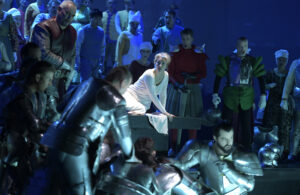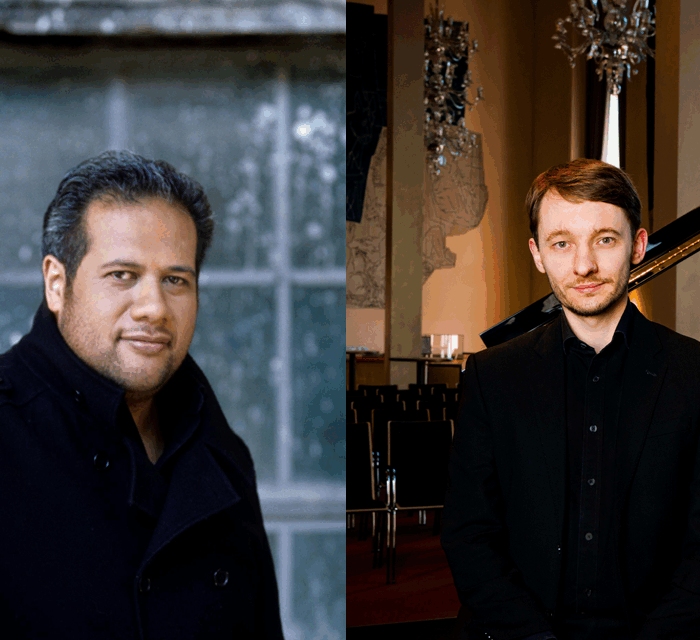
Deutsche Oper Berlin 2025-26 Review: Tannhäuser
By Laura Servidei(Photo credit: © Bettina Stöss)
Of all Wagner’s operas, “Tannhäuser” remains one of his most contentious works — a piece celebrated for balancing sublime beauty with moments of profound unease. At its core lies the agonizing struggle between sacred and profane love, embodied in the sensual allure of the Venusberg and the rigid piety of the Wartburg court — a conflict waged within the soul of its titular knight and minstrel.
This tension also reflects the broader clash between the fading world of ancient gods, represented by Venus, and the rising era of Christianity. Set in 13th-century Germany, the opera draws upon the historical tradition of the “Minnesänger” — noble poet-musicians who entertained the courts and competed in prestigious song contests.
A Knight Torn Between Worlds
The Minnesinger Tannhäuser has spent a year under the spell of Venus, the goddess of love, in her grotto in the Venusberg. He breaks her enchantment by calling on the Virgin Mary and returns to the court of the Landgrave of Thuringia, where a chaste maiden awaits him: Elisabeth. After they rejoice in their renewed love, a singing contest on “the true nature of love” is held. While the other minstrels praise platonic love, Tannhäuser delivers a frenzied ode to sensual pleasure, nearly confessing his orgiastic year in the Venusberg. The court revolts in fury, but the devastated Elisabeth intercedes, pleading for his chance at redemption. The Landgrave exiles Tannhäuser, ordering him on a pilgrimage to Rome.
When the pilgrims return, Tannhäuser is missing. Having failed to receive the Pope’s forgiveness despite his penance, he resolves to return to Venus. Just as she appears, Elisabeth’s funeral procession arrives; she has died praying for his soul. Pilgrims then enter, displaying the Pope’s staff that has miraculously sprouted leaves: Tannhäuser’s soul has been saved.
Powerful, if Puzzling, Imagery
Staging such material is no simple task. Director Kirsten Harms wisely sets the action in the Middle Ages, as the libretto requires, employing medieval imagery and clothing (costumes by Bernd Damovsky). Suits of armor are ubiquitous, hanging from the ceiling and worn by the singers, a puzzling, noisy choice for a singing contest. A central platform, which rises and falls, creates the different settings: Venus’s nymphs emerge on it, dancing suggestively, while the pilgrims ascending to Rome resemble souls rising from hellfire. The visuals are often striking, with the Thuringian nobles in colorful, imaginative costumes that enliven the contest. Conversely, the Act Two love duet places Tannhäuser and Elisabeth in a stark, softly lit blue room, while Wolfram stands armored in the background, looking like the most awkward third wheel.
Sacred and Sensual: A Masterful Portrayal
A particularly effective directorial choice was the casting of a single singer — Camilla Nylund — in the dual roles of Venus and Elisabeth, suggesting that a woman embodies both sensual and sacred love, transcending one-dimensional archetypes. While not a novel concept, the execution was superb. Nylund masterfully distinguished the two characters through both her acting and vocal artistry. Her brilliant, high soprano proved ideally suited to Elisabeth’s music, where her bright high notes soared with ease over the more grounded, harmonically simple score, expressing pure devotion. In contrast, she navigated Venus’s more complex and harmonically challenging music by harnessing her powerful middle register to convey lust and defiance.
The most stunning demonstration of her versatility came at the opera’s conclusion. As the dying Elisabeth, Nylund delivered her prayer to the Virgin Mary “Allmächt’ge Jungfrau, hör mein Flehen!” with the most tender, angelic tone, her potent soprano and ravishing legato conveying profound emotion. Then, when Venus reappeared with her lush, overtly sensual style, the transformation was a shock — it was difficult to believe it was the same singer.
A Tenor of Luminous Power
The role of Tannhäuser was sung by Klaus Florian Vogt, one of the most sought-after Wagnerian tenors of his generation, who delivered a splendid performance. His signature sound — an unusual, bright, and luminous timbre — deviates from the typical Heldentenor, yet his powerful projection and the sheer beauty of his tone were utterly compelling.
His hymn to Venus, a leitmotiv appearing for the first act in the Venusberg, and then returning during the song context, “Dir Töne Lob,” was full of virile, excited power. At the end of Act Two, his plea for mercy, “Ach, erbarm dich mein!”, pierced effortlessly through the full orchestra and chorus. He retained this stamina into Act Three, navigating the demanding “Romerzählung” (the tale of his pilgrimage) with unwavering control. This long arioso requires dynamic shifts and high notes to express vastly different emotions, which Vogt masterfully achieved, letting his voice turn raspy with rage one moment and resume its androgynous sweetness the next. A spectacular performance indeed.
Notable Minstrels and a Noble Landgrave
As Tannhäuser’s friend, fellow minstrel, and rival for Elisabeth’s love, Wolfram von Eschenbach sings the opera’s most famous aria, “O du, mein holder Abendstern.” Baritone Thomas Lehman delivered a remarkable performance, his smooth voice displaying an excellent legato and a suitably dreamy quality. Unfortunately, the staging, positioning him in a corner while crouched over the dying Elisabeth, somewhat undermined the aria’s intended atmosphere.
Other notable minstrels included Kangyoon Shine Lee, who sang Walther with a light yet well-projected and pleasant tenor, and Michael Bachadze as a compelling Biterolf, his deep, smooth baritone perfectly conveying the character’s disdain. Christof Fischesser was an authoritative Landgrave Hermann, his sonorous bass commanding respect.
Orchestral and Choral Excellence
Conductor Axel Kober led the Deutsche Oper Orchestra in a sensitive and detailed reading of Wagner’s score. He provided constant, supportive accompaniment for the singers, his guiding hand always evident. The brass section sounded magnificent, and the chorus was arguably the star of the evening — their “Pilgrims’ Chorus” was truly inspired, delivered with a gravitas that was utterly heartrending.
Categories
News


